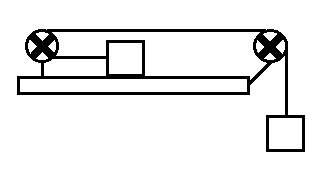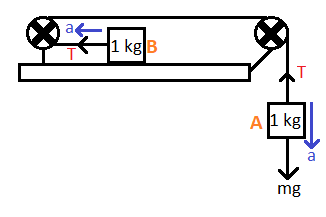
Calculate the tension in the string shown in the figure. All the surfaces are frictionless. Both the blocks have a mass of 1kg. (Take $g=10m/{{s}^{2}}$)

A. 5 N
B. 10 N
C. 7 N
D. 2 N

Answer
566.4k+ views
Hint: We are given two blocks of mass each 1 kg attached to two pulleys. Since the string throughout the system is the same and the mass of the two blocks are same the tension on the string will also be the same. To find the value of tension we need to draw the free body diagram of the two mass blocks and solve the free body diagram. Thus we get the solution.
Formula used:
Weight of the body,
$w=mg$
Force due to acceleration,
$F=ma$
Complete step by step answer:
In the question we are given two blocks connected by a string and attached to two pulleys.
It is said that all the surfaces are frictionless.
We are also given that the masses of the blocks are 1 kg.
Therefore we have, m = 1 kg.
We need to find the tension on the string. For that first let us draw the free body diagram of the two blocks.

The two blocks are named A and B in the diagram.
Since the string is the same throughout the system, we know that the tension acting on the string will be equal.
Therefore let T be the tension acting on the string.
Now let us consider the block A.
The free body diagram of block A is depicted in the above figure.
The forces acting on the body are; the weight of the body vertically downwards due to gravitational force, the tension on the string acting in opposite direction to the gravitational force, force acting due to acceleration.
Since weight of the block and tension on the string is in opposite direction, the total force acting on the block is the resultant of these two forces, i.e.
\[F=mg-T\], were ‘mg’ is the weight of the body and ‘T’ is tension.
And the force due to acceleration of the block,
$F=ma$
Therefore we can equate both these forces together.
Thus we get,
$mg-T=ma$
This is the equation of the free body diagram of block A.
Now let us consider block B.
The free body diagram of block B is also given in the figure.
The block B is placed on the horizontal plane. Hence there is no gravitational force acting on the body.
Therefore the forces acting on the block B are; tension of the string and force due to acceleration.
Therefore we can write,
$T=ma$
This is the equation of the free body diagram of block B.
Now we can substitute this in the equation of the free body diagram of block A.
Substituting this we get,
$\begin{align}
& mg-ma=ma \\
& m\left( g-a \right)=ma \\
& g-a=a \\
& g=2a \\
\end{align}$
In the question we are given that,
$g=10m/{{s}^{2}}$
Therefore we get acceleration as,
$\begin{align}
& a=\dfrac{g}{2} \\
& a=\dfrac{10}{2} \\
& a=5m/{{s}^{2}} \\
\end{align}$
Substituting the value of acceleration in the equation of block B, we get
$\begin{align}
& T=ma \\
& T=1\times 5 \\
& T=5N \\
\end{align}$
Therefore we get the tension on the string as, $T=5N$
Hence the correct answer is option A.
Note:
This is an application of Newton’s laws of motion.
Newton’s laws of motion help us to relate the motion of an object to the forces acting on that object.
The first law of motion is based on Galileo’s law of inertia which states that everybody continues in the state of rest until an external unbalanced force acts on it.
The first law of Newton says that if there is no external force acting on a body, then its acceleration will be zero. Acceleration of a body can only be non-zero if there is external force acting on it.
The second law is based on momentum. According to this law the rate of change of momentum of any body will always be proportional to the force applied and will be in the direction of the applied force.
According to Newton force is a mutual interaction between two bodies. Thus he stated in his third law that to every action or every force that acts in nature there will always be an equal and opposite reaction.
Formula used:
Weight of the body,
$w=mg$
Force due to acceleration,
$F=ma$
Complete step by step answer:
In the question we are given two blocks connected by a string and attached to two pulleys.
It is said that all the surfaces are frictionless.
We are also given that the masses of the blocks are 1 kg.
Therefore we have, m = 1 kg.
We need to find the tension on the string. For that first let us draw the free body diagram of the two blocks.

The two blocks are named A and B in the diagram.
Since the string is the same throughout the system, we know that the tension acting on the string will be equal.
Therefore let T be the tension acting on the string.
Now let us consider the block A.
The free body diagram of block A is depicted in the above figure.
The forces acting on the body are; the weight of the body vertically downwards due to gravitational force, the tension on the string acting in opposite direction to the gravitational force, force acting due to acceleration.
Since weight of the block and tension on the string is in opposite direction, the total force acting on the block is the resultant of these two forces, i.e.
\[F=mg-T\], were ‘mg’ is the weight of the body and ‘T’ is tension.
And the force due to acceleration of the block,
$F=ma$
Therefore we can equate both these forces together.
Thus we get,
$mg-T=ma$
This is the equation of the free body diagram of block A.
Now let us consider block B.
The free body diagram of block B is also given in the figure.
The block B is placed on the horizontal plane. Hence there is no gravitational force acting on the body.
Therefore the forces acting on the block B are; tension of the string and force due to acceleration.
Therefore we can write,
$T=ma$
This is the equation of the free body diagram of block B.
Now we can substitute this in the equation of the free body diagram of block A.
Substituting this we get,
$\begin{align}
& mg-ma=ma \\
& m\left( g-a \right)=ma \\
& g-a=a \\
& g=2a \\
\end{align}$
In the question we are given that,
$g=10m/{{s}^{2}}$
Therefore we get acceleration as,
$\begin{align}
& a=\dfrac{g}{2} \\
& a=\dfrac{10}{2} \\
& a=5m/{{s}^{2}} \\
\end{align}$
Substituting the value of acceleration in the equation of block B, we get
$\begin{align}
& T=ma \\
& T=1\times 5 \\
& T=5N \\
\end{align}$
Therefore we get the tension on the string as, $T=5N$
Hence the correct answer is option A.
Note:
This is an application of Newton’s laws of motion.
Newton’s laws of motion help us to relate the motion of an object to the forces acting on that object.
The first law of motion is based on Galileo’s law of inertia which states that everybody continues in the state of rest until an external unbalanced force acts on it.
The first law of Newton says that if there is no external force acting on a body, then its acceleration will be zero. Acceleration of a body can only be non-zero if there is external force acting on it.
The second law is based on momentum. According to this law the rate of change of momentum of any body will always be proportional to the force applied and will be in the direction of the applied force.
According to Newton force is a mutual interaction between two bodies. Thus he stated in his third law that to every action or every force that acts in nature there will always be an equal and opposite reaction.
Recently Updated Pages
Why are manures considered better than fertilizers class 11 biology CBSE

Find the coordinates of the midpoint of the line segment class 11 maths CBSE

Distinguish between static friction limiting friction class 11 physics CBSE

The Chairman of the constituent Assembly was A Jawaharlal class 11 social science CBSE

The first National Commission on Labour NCL submitted class 11 social science CBSE

Number of all subshell of n + l 7 is A 4 B 5 C 6 D class 11 chemistry CBSE

Trending doubts
What is meant by exothermic and endothermic reactions class 11 chemistry CBSE

10 examples of friction in our daily life

One Metric ton is equal to kg A 10000 B 1000 C 100 class 11 physics CBSE

1 Quintal is equal to a 110 kg b 10 kg c 100kg d 1000 class 11 physics CBSE

Difference Between Prokaryotic Cells and Eukaryotic Cells

What are Quantum numbers Explain the quantum number class 11 chemistry CBSE




